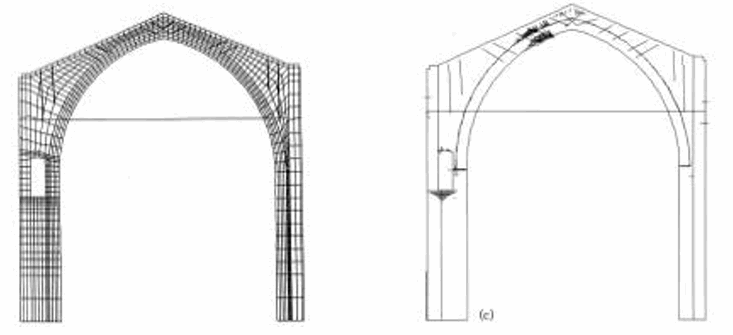Ronca[1], F. Genna[2], A. Franchi1
- DIS, Politecnico di Milano, Piazza L. da Vinci, 32, 20133 Milan, Italy – ronca@stru.polimi.it; franchi@stru.polimi.it
- Dip. Ing. Civile, University of Brescia, Via Branze 38, Brescia, Italy – genna@ing.unibs.it
ABSTRACT
The structural members of old masonry buildings are essentially plane walls, arches and vaults; both types of structures are usually designed to support vertical loads only. Today’s engineers are often confronted with the task of studying, to the best of their ability, the behaviour of structural members of old masonry buildings, and, in doing so, they must face at least three very different situations.
The first is the need to check the safety of the structural parts against their original design loads; the second is the need to check the safety of the structural parts against different and new loading conditions, because of new destinations of the building; the third occurs when an old, possibly historical building happens to be in a seismic zone.
The features of masonry, seen as a material, make it necessary to resort to numerical analysis to try and understand its actual behaviour. The paper summarises what can be done by applying computational techniques to study old masonry buildings; in doing so, we will make reference to the Finite Element Method as the standard numerical tool, even if, with the aim of modelling the complex texture of masonry, other techniques might be employed, such as, for instance, the Boundary Element Method.
The paper underlines that, in any case, when dealing with the task of interpreting the result of a FEM analysis of an old structure, a mosaic of different assumed structural models and analysis methods have to be compared with each other. Old masonry structures can reach different, sometimes unpredictable limit states, with different safety coefficients. Such complexity of behaviour requires a broad spectrum of numerical analysis tools, including extensions of simplified methods proposed in the past both for the elastic and for the limit analysis.
The difficulty of performing numerical analyses in the non-linear range, specially in the presence of brittle behaviour, with the aim of obtaining reasonably accurate information and possibly useful from the engineering viewpoint are illustrated.
Then by means of examples concerning both walls and arches, some results obtained by means of the numerical analysis methods of old masonry buildings are compared.
Key words: old masonry, numerical models, constitutive laws, FEM analysis.
histor05



